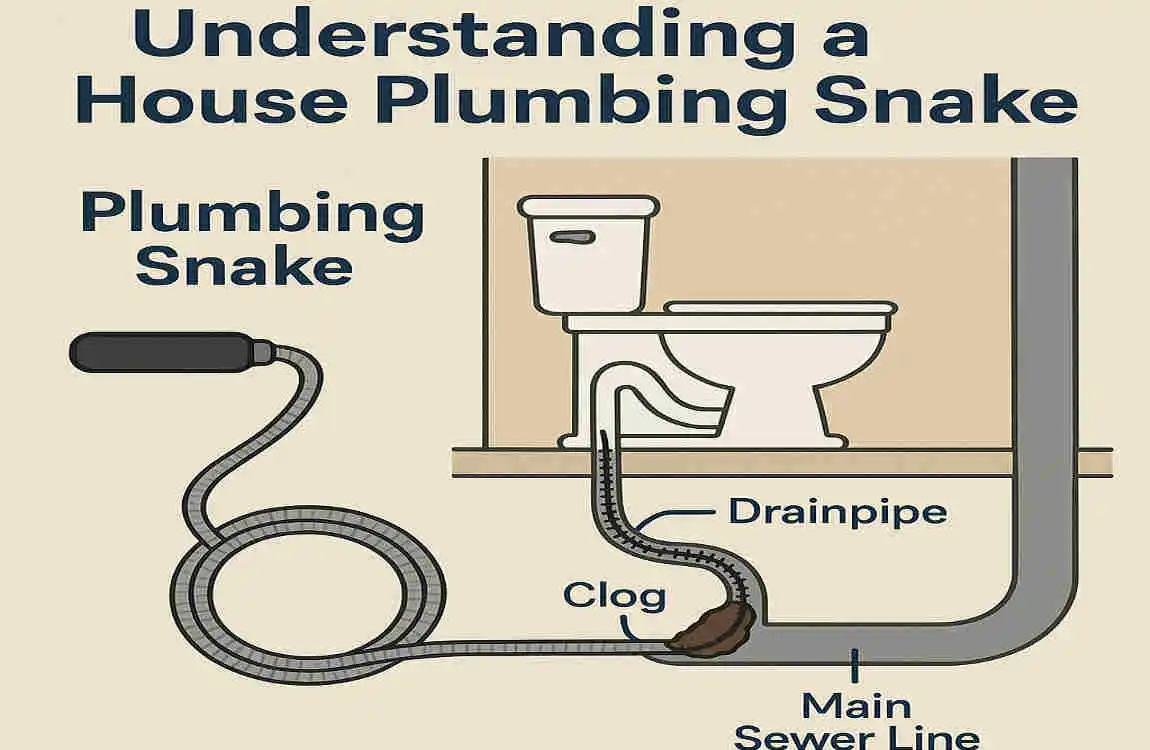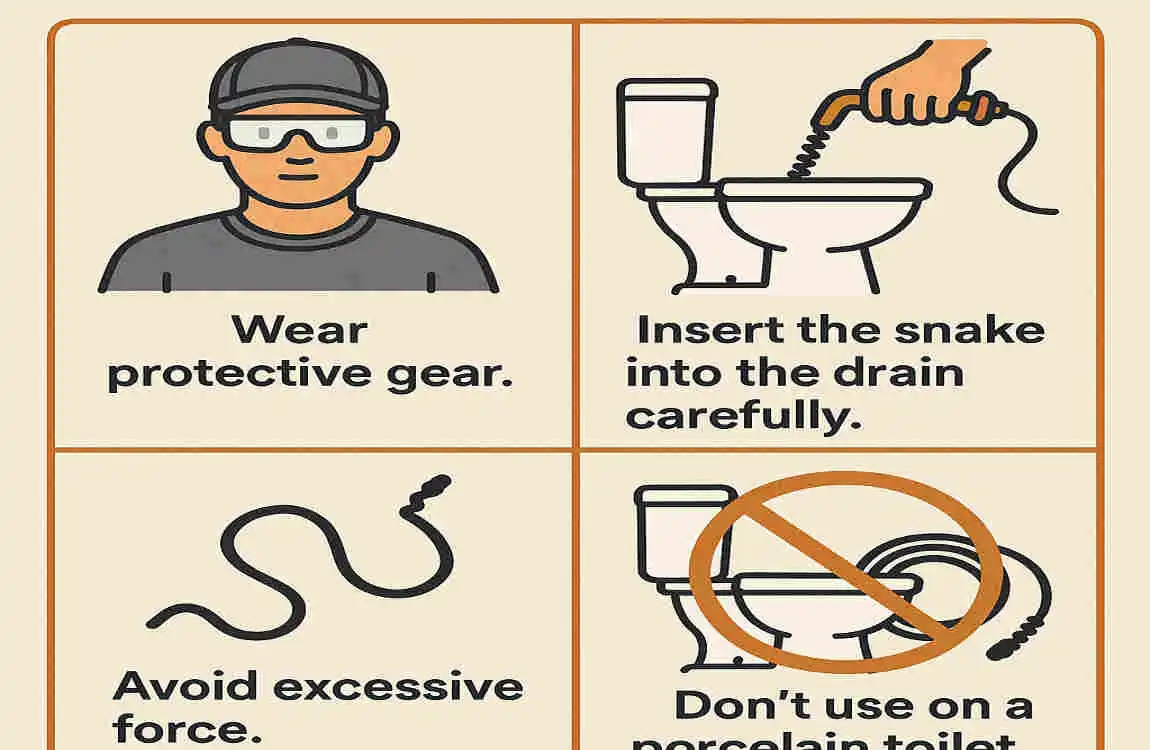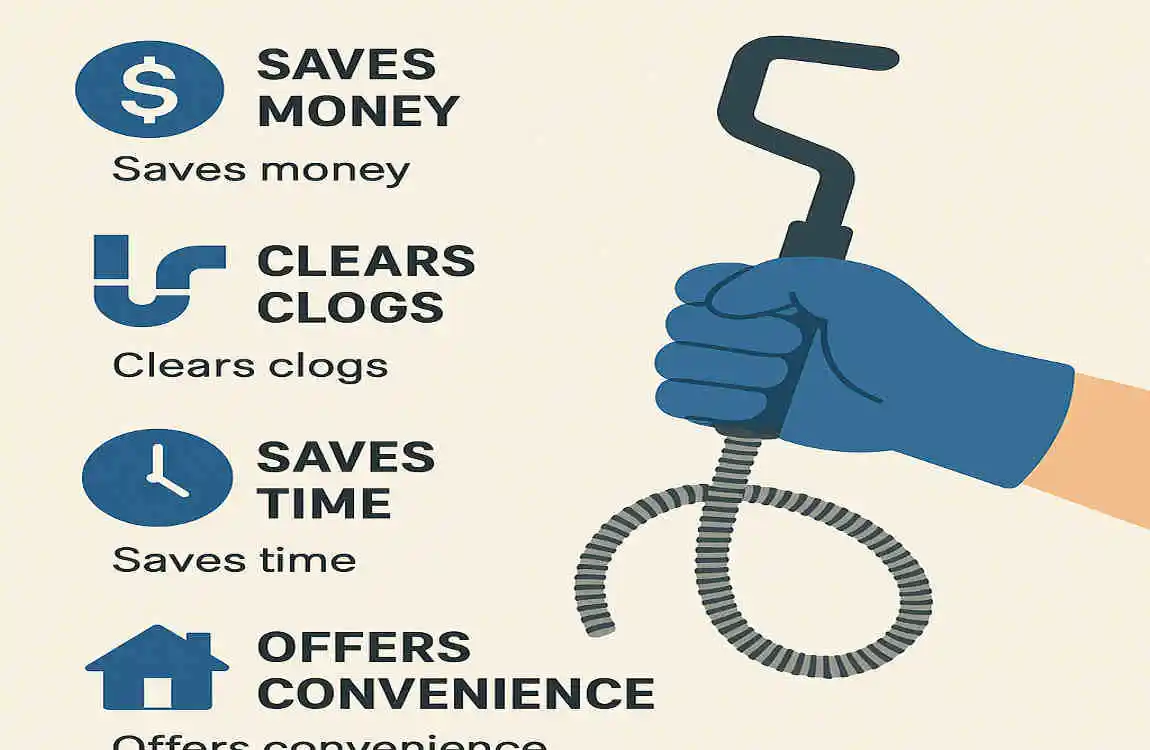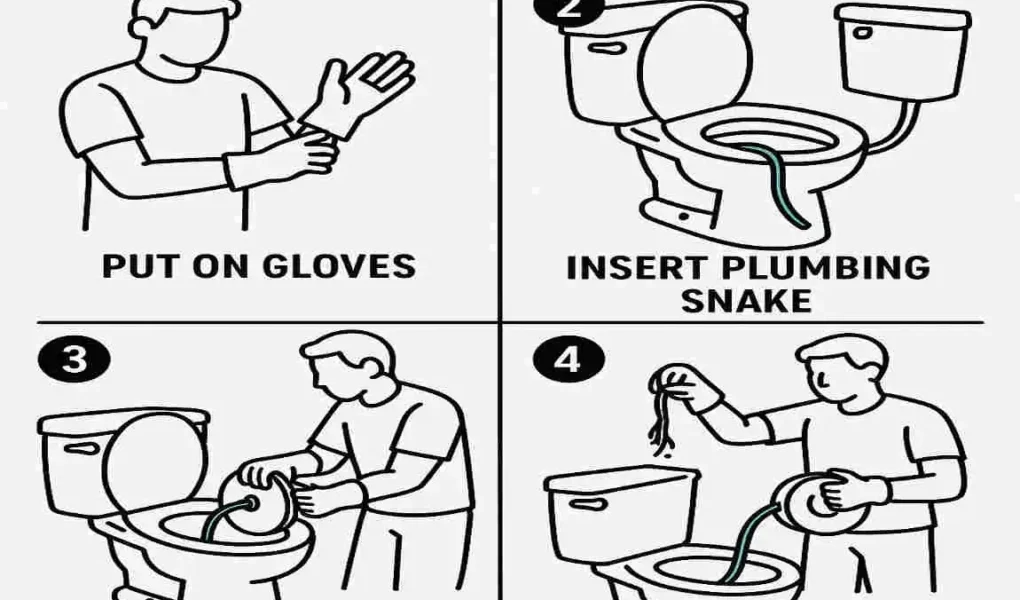Toilet clogs are one of those common household plumbing issues that can really throw a wrench in your day. You know the feeling – you flush, and instead of the satisfying whoosh of water, you’re met with an ominous gurgle and rising water levels. It’s frustrating, inconvenient, and if you’re not careful, it can lead to a big mess.
But don’t worry, because there’s a simple, effective, and eco-friendly solution that every homeowner should know about: the house plumbing snake. Also known as a toilet auger, this handy tool is your secret weapon against stubborn toilet clogs.
Understanding a House Plumbing Snake

What is a Plumbing Snake and Why You Need One
A plumbing snake, also called a toilet auger or drain auger, is a flexible, coiled cable designed to reach deep into your toilet’s drain and break up or remove clogs. It’s an essential tool for any homeowner because it lets you clear stubborn clogs without resorting to harsh chemicals that can damage your pipes or harm the environment.
Types of Plumbing Snakes for Toilets
Not all plumbing snakes are created equal, especially when it comes to toilets. Here are the main types you’ll encounter:
- Toilet Augers: Designed specifically for toilets, these feature a protective rubber sleeve to prevent porcelain scratching. They usually have a curved end to navigate the toilet’s trap.
- Closet Augers: Similar to toilet augers but with a more extended reach, these are ideal for deeper clogs.
- General Purpose Snakes: While not suitable for toilets, these can work in a pinch. Just be careful not to scratch the toilet bowl.
How a Plumbing Snake Works
Using a plumbing snake is like going on a treasure hunt – except the treasure is a clear drain! Here’s how it works:
- Insertion: You feed the snake’s cable into the toilet’s drain opening.
- Cranking: As you slowly crank the handle, the cable extends deeper into the drain.
- Clog Detection: When the cable hits resistance, you’ve found the clog.
- Breakup or Retrieval: You can either push through the clog to break it up or latch onto it and pull it out.
Advantages of Mechanical Unclogging
Using a plumbing snake has several key advantages over chemical drain cleaners:
- Safer for Pipes: Mechanical unclogging is gentler on your plumbing system.
- Environmentally Friendly: No harsh chemicals to worry about.
- More Effective: Snakes can tackle stubborn clogs that chemicals can’t.
- Reusable: A good quality snake can last for years with proper care.
Signs You Need to Use a Plumbing Snake on Your Toilet
Symptoms of Serious Toilet Clogs
How do you know when it’s time to break out the plumbing snake? Look out for these telltale signs:
- Plunger Fails: If multiple plunges don’t clear the clog, it’s time for the snake.
- Slow Draining: If water drains slowly, there’s a partial blockage.
- Gurgling Sounds: Unusual noises when flushing can indicate a clog.
- Multiple Clogs: Frequent clogs in the same toilet suggest a persistent problem.
When to Skip Chemicals and Use a Snake
While chemical drain cleaners might seem like a quick fix, they’re often not the best choice. Here’s when you should skip them and go straight for the snake:
- Frequent Clogs: If you’re constantly dealing with clogs, chemicals won’t solve the underlying issue.
- Environmental Concerns: If you’re trying to reduce your chemical use, the snake is the way to go.
- Safety: Chemical cleaners can be hazardous, especially in homes with children or pets.
- Effectiveness: For stubborn clogs, a snake is often more effective than chemicals.
Safety and Environmental Benefits of Mechanical Snaking
Using a plumbing snake isn’t just effective – it’s also the safer, greener choice:
- No Chemical Exposure: You avoid the risks associated with harsh drain cleaners.
- Protects Plumbing: Mechanical unclogging is gentler on your pipes.
- Eco-Friendly: You’re not pouring harmful chemicals down the drain.
- Reusable: A plumbing snake can be used multiple times, reducing waste.
Tools and Preparations Needed Before Snaking Your Toilet

Essential Tools for the Job
Before you start snaking your toilet, make sure you have these tools on hand:
- Plumbing Snake (Toilet Auger): The star of the show!
- Rubber Gloves: To keep your hands clean and protected.
- Old Towels: For mopping up any spills or drips.
- Bucket: Handy for catching water if you need to remove some from the bowl.
- Disinfectant: For cleaning up after the job.
Preparing Your Workspace
A little prep work can save you a big mess:
- Clear the Area: Remove any nearby items that could get in the way or get wet.
- Lay Down Towels: Place towels around the base of the toilet to catch any drips.
- Have a Bucket Ready: Keep a bucket nearby in case you need to remove water from the bowl.
- Wear Gloves: Put on your rubber gloves before you start.
Safety Tips
Safety first! Here are some key precautions:
- Turn Off Water Supply: If you’re concerned about overflow, locate the water shut-off valve behind the toilet and turn it clockwise to stop the flow.
- Be Gentle: Don’t force the snake – you could damage the toilet or pipes.
- Ventilate: If you’re sensitive to odors, open a window or turn on a fan.
Step-by-Step Guide: How to Use a House Plumbing Snake for Toilet Clogs
Now that you’re prepped and ready, let’s walk through using a plumbing snake to clear your toilet clog.
Put on Rubber Gloves and Prepare the Area
Before you start, slip on those rubber gloves. Then, lay down some old towels around the base of the toilet to catch any drips or spills. Have your bucket and disinfectant nearby, just in case.
Insert the Head of the Snake into the Toilet Bowl Drain Opening
Carefully insert the head of the plumbing snake into the drain opening at the bottom of the toilet bowl. Make sure the snake is fully extended and ready to go.
Slowly Crank the Handle Clockwise While Feeding the Cable into the Drain
With the snake’s head in the drain, start slowly cranking the handle clockwise. As you do this, gently feed more of the cable into the drain. Take your time and be patient.
Feel for Resistance Indicating the Clog Location
As you feed the cable deeper into the drain, pay attention to any resistance you feel. This is a sign that you’ve reached the clog. The location of the resistance can give you clues about the nature of the clog.
Maneuver Carefully Through Pipe Bends
Toilets have curved traps that make snaking a bit tricky. If you feel the cable hit a bend, gently maneuver it around the curve. Don’t force it – you could damage the pipes.
Push Through or Latch Onto the Clog
Once you’ve reached the clog, you have two options:
- Push Through: If the clog feels soft, you can push the cable through it to break it up.
- Latch On: If the clog is more solid, try to maneuver the cable’s hook around it to latch on.
Gently Retract the Snake
After you’ve pushed through or latched onto the clog, start gently retracting the snake. If you’ve broken up the clog, the water should begin draining. If you’ve latched on, you can pull the clog out entirely.
Repeat the Feeding and Retracting Process as Needed
Stubborn clogs might require multiple attempts. If the water isn’t draining after your first try, repeat the process of feeding the cable in, maneuvering around the clog, and retracting it.
Flush the Toilet Carefully
Once you think you’ve cleared the clog, it’s time to test it out. Flush the toilet carefully and watch to see if the water drains normally. If it does, congratulations – you’ve successfully cleared the clog!
Clean the Plumbing Snake Thoroughly After Use
After you’ve finished, it’s essential to clean your plumbing snake. Rinse it off with water, then use disinfectant to sanitize it. Let it dry completely before storing it away for next time.
Tips and Precautions When Using a Plumbing Snake on Toilets

Avoid Forcing the Snake
One of the most important things to remember when using a plumbing snake is never to force it. If you feel strong resistance, stop and reassess. Forcing the snake could damage your toilet or pipes.
Use the Right Type of Snake Cable
For toilets, it’s best to use a snake with a flexible, softer cable. This will help you navigate the toilet’s curves without causing damage. Avoid using a snake designed for sinks or showers, as their cables might be too stiff.
What to Do If the Clog Persists
If you’ve tried snaking the toilet several times and the clog still won’t budge, it’s time to consider other options:
- Try a Different Approach: Sometimes, switching to a plunger or using a combination of plunging and snaking can help dislodge stubborn clogs.
- Check for Other Issues: If the clog persists, there might be a more serious issue with your plumbing system.
- Call a Professional: If all else fails, it’s time to call a plumber to diagnose and fix the problem.
When It’s Time to Call a Professional Plumber
While many toilet clogs can be handled with a plumbing snake, there are times when you should call a professional:
- Persistent Clogs: If the same toilet keeps clogging despite your best efforts.
- Slow Drains Throughout the House: This could indicate a larger issue with your plumbing system.
- Visible Damage: If you notice cracks or leaks in your toilet or pipes.
- Unfamiliar Noises or Smells: Strange sounds or odors coming from your toilet could signal a serious problem.
Benefits of Knowing How to Use a House Plumbing Snake

Saves Money on Plumber Calls and Harsh Chemicals
One of the most significant benefits of learning how to use a house plumbing snake is the money you’ll save. Instead of calling a plumber for every clog or buying expensive chemical drain cleaners, you can handle the problem yourself with a simple, reusable tool.
Environmentally Friendly and Safe for Plumbing Systems
Using a plumbing snake is not only cost-effective – it’s also better for the environment and your plumbing system. You avoid pouring harsh chemicals down the drain, which can harm the ecosystem and corrode your pipes over time. Mechanical unclogging is a safer, greener choice.
Empowers Homeowners with Quick, Effective DIY Skills
Knowing how to use a house plumbing snake gives you a sense of empowerment as a homeowner. You’re no longer at the mercy of clogs – you have the skills and tools to tackle them quickly and effectively. This DIY know-how can save you time, money, and stress in the long run.
How to Use a House Plumbing Snake for Toilet Clogs: FAQ
What is a House Plumbing Snake?
A house plumbing snake, also known as a toilet auger or drain snake, is a long, flexible tool designed to clear clogs in your plumbing system. It consists of a long wire coil with a corkscrew-like tip that you feed into your pipes until it encounters the obstruction . The protective sleeve on a toilet snake ensures that your toilet bowl remains undamaged during the unclogging process.
How Does a Plumbing Snake Work?
A plumbing snake works by sliding through your pipes to poke, prod, and pull clogs loose. The point of the snake is usually grooved like a screw to help it bore into anything lodged in your pipes . By maneuvering the snake through the toilet’s drain, you can dislodge or break up the clog, allowing water to flow freely again.
When Should I Use a Plumbing Snake on My Toilet?
You should use a plumbing snake on your toilet when a plunger fails to clear the clog. If you’ve tried plunging multiple times without success, it’s time to reach for the snake . Additionally, if your toilet is draining slowly or not at all, or if you hear gurgling sounds when flushing, a plumbing snake may be necessary to remove the blockage.
How Do I Use a Plumbing Snake on My Toilet?
Using a plumbing snake on your toilet is a straightforward process. Here’s a step-by-step guide:
- Prepare the area: Put on rubber gloves and place a towel underneath your toilet to catch any spills .
- Insert the snake: Pull the handle of the toilet snake back until only the end of the snake is visible at the end of the rod. Rest the curved section of the rod at the bottom of the bowl .
- Feed the snake: Slowly feed the snake into the toilet’s drain opening, cranking the handle to unfurl the snake as you go .
- Locate the clog: Continue feeding the snake until you feel resistance, indicating that you’ve reached the clog.
- Break up or remove the clog: Use the snake to break up the clog or latch onto it and pull it out.
- Test the toilet: Give the toilet a couple of flushes to check if the water goes down smoothly. If it empties out fast and completely, the blockage is likely cleared. If not, give snaking another go.
What Should I Do If the Clog Persists After Using a Plumbing Snake?
If the clog persists after using a plumbing snake, there are a few things you can try:
- Repeat the process: Give snaking another go, as sometimes it takes multiple attempts to fully clear a stubborn clog .
- Check for other issues: If both toilets in your home are affected, you may need to remove the farthest toilet and run the snake down the open line there .
- Consider professional help: If you suspect tree roots have infiltrated your sewer pipe or if the clog is severe, it’s best to call a professional plumber for assistance.




